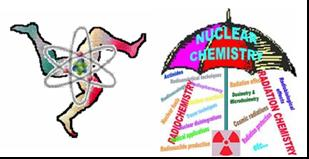Speaker
Dr
Ignazio Vilardi
(Nuclear Medicine Department, Multimedica Scientific Institute, Sesto San Giovanni (MI), Italy)
Description
Introduction
Most of the waste generated at a cyclotron/PET facility presents high radioactivity created by target irradiation. The main sources of this waste are foils, spent targets, materials produced during accelerator maintenance, chemicals used in the separation of radioisotopes from the target materials and for labelling of radiopharmaceuticals. Usually, these materials are collected on-site in a designated area and then transferred to authorized companies for disposal from the site. Aim of this study is the qualitative and quantitative characterization of waste coming from labelling tracer procedures and cyclotron maintenance.
Materials and Methods
The PET centre at San Raffaele Scientific Institute is equipped with two cyclotrons, IBA Cyclone (18 MeV) and CTI Eclipse (11 MeV). 18F and 11C are produced by means of proton bombardment on [18O]H2O with Ag/Nb target (Havar/Ti foils) and on [14N]N2 + 1% O2 with Al target (Al foil), respectively. Typical productions for 18F and 11C, with a 60 min irradiation at a beam current of 50 microampere (18F) and 35 microampere (11C), range from 50 to 55 GBq.
Two types of waste were considered: solid produced from cyclotron maintenance (cotton applicator, paper, gloves, QMA cartridges, stripper target) and liquid from FDG synthesis. Five solid and three liquid Al containers (10 kg for solid and 5 kg for liquid waste), relative to seven months, were analyzed. Spectroscopic measurements were performed using an High-Purity Germanium detector with 18% relative efficiency and 0.14% energy resolution at 1332 keV. Energy and efficiency calibrations were performed with 152Eu and 133Ba certified sources.
A 1 ml sample of liquid waste was measured in the same geometry used for efficiency calibration. The total activity was then obtained by normalizing for the weight of the liquid in the container. In order to allow direct measurements of activity in the container (both liquid and solid waste), such total activity value was then used to determine correction factors for the container geometry (in the energy range from 50 to 2000 keV) at 15 cm far from the detector. In order to assess our technique, one Al solid container was sent for spectroscopic analysis to an ISO 9001 certified laboratory (LENA – University of Pavia).
Results
Analysis of waste of a typical solid container, filled in 2/3 months, showed the presence of relatively long-lived radionuclides: 7Be, 22Na, 48V, 51Cr, 54Mn, 56Co, 57Co, 58Co, 60Co, 65Zn, 95mTc, 108mAg, 109Cd, 110mAg, 182Ta. Measured activities ranged from 0.2 to 6.5 MBq. The main contribution arose from 7Be (6 MBq, T1/2=53.12 days), 58Co (3.5 MBq, T1/2=70.86 days) and 65Zn (2 MBq, T1/2=244.26 days). Liquid waste data confirmed the presence of 22Na, 51Cr, 54Mn, 56Co, 57Co, 58Co, 65Zn and their total activities ranged from 0.3 to 5 MBq. Spectroscopic analysis carried out by LENA confirmed same nuclides and activities within 20% of difference. The kind of radionuclides found in this study are inherent with the targets and foils employed for proton irradiation. In particular 7Be is likely obtained from the nuclear reaction 7Li(p,n)7Be, 48V from 48Ti(p,n)48V, all Co isotopes from natFe(p,x)Co or natNi(p,x)Co, 54Mn from 54Fe(p,n)54Mn, 65Zn from 65Cu(p,n)65Zn and 109Cd from 109Ag(p,n)109Cd. Short-lived contaminants could not be detected from our delayed measurements.
Conclusion
The presence of long-lived contaminants in the activated parts of accelerators (e.g. targets, foils) have been well established. Our results indicate that attention should also be given on waste produced during maintenance procedures and that long-lived radionuclides are present in the residuals of tracer synthesis, even if yield of radionuclides can vary depending on several factor such as cross section, exposure time, beam current and type of maintenance. Due to the presence of long-lived radionuclides, waste in-house storage is not useful and, therefore, waste disposal by authorized companies is recommended. However, procedures for waste minimization should be set-up as part of the safety assessment, to control potential risks and to reduce operating costs.
Primary author
Dr
Ignazio Vilardi
(Nuclear Medicine Department, Multimedica Scientific Institute, Sesto San Giovanni (MI), Italy)
Co-authors
Dr
Annarita Savi
(Nuclear Medicine Department, San Raffaele Scientific Institute, Milan, Italy)
Dr
Luigi Gianolli
(Nuclear Medicine Department, San Raffaele Scientific Institute, Milan, Italy)
Prof.
Maria Carla Gilardi
(IBFM-CNR, Milan, Italy)
Dr
Massimo Gasparini
(Nuclear Medicine Department, Multimedica Scientific Institute, Sesto San Giovanni (MI), Italy)
Dr
Riccardo Calandrino
(Health Physics Department, San Raffaele Scientific Institute, Milan, Italy)
Dr
Rossella Parisi
(Health Physics Department, San Raffaele Scientific Institute, Milan, Italy)




